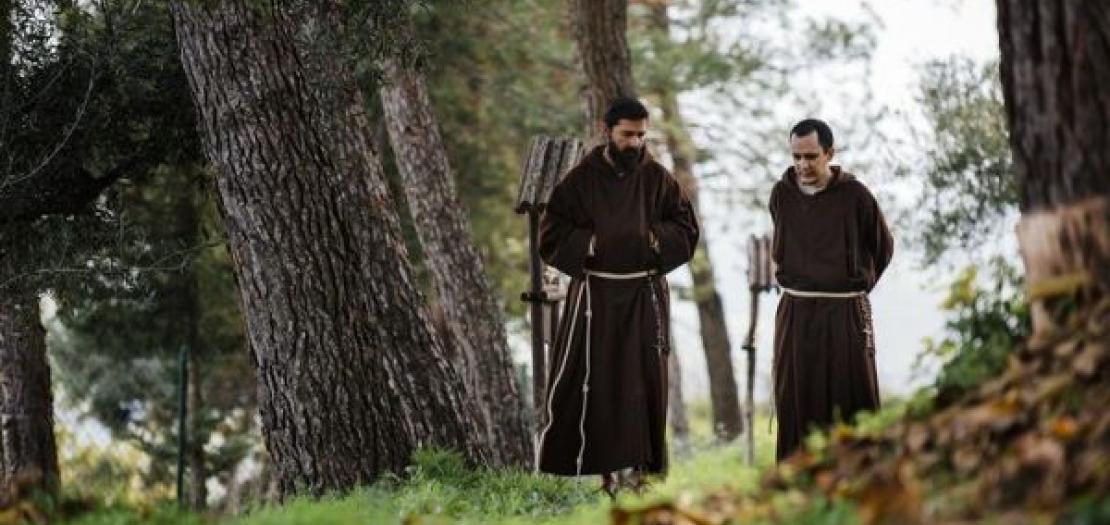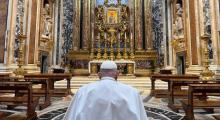Issued by the Catholic Center for Studies and Media - Jordan. Editor-in-chief Fr. Rif'at Bader - موقع أبونا abouna.org

The weight of playing St. Pio of Pietrelcina, more popularly known as Padre Pio, one of the most popular saints of the 20th century, was “enormous,” Shia LaBeouf told CNA in late May.
The new film “Padre Pio,” starring “Transformers” and “Fury” star LaBeouf, airs in theaters June 2 and portrays the Italian friar in his early 20s immersed in the suffering of the residents of San Giovanni Rotondo, in eastern Italy, where his monastery is located.
The film, rated R for some explicit violence and language, portrays powerful scenes of Padre Pio ministering to the townspeople and enduring his own spiritual battles with the devil amid the chaos of a violent political clash between the mainly impoverished socialists and the wealthy ruling class, ultimately resulting in a brutal massacre.
Abel Ferrara, the film’s director, called the killings a “nightmare event” and added that all of it came together in the film.
“There’s not a political story and a Padre Pio story. He’s a member of that community. He’s feeling it. He knows what’s going on, and he’s interconnected with those people. And those people are very interconnected to him,” Ferrara said.
LaBeouf, Brother Alexander Rodriguez — who plays a real Franciscan Capuchin in the film — and Ferrara, the film’s director, also addressed a scene in the film that shows the devil in the form of a naked woman as well as the saint’s use of profanity in another scene.
When asked what the message of the film was, Ferrara said that there was nothing specific but added that St. Pio’s message is “compassion and love in the day to day life, not just the hour you’re in church.”
Playing Pio
LaBeouf told CNA that playing the role of the saint while being immersed in his monastery and town added to the intensity.
“It’s enormous pressure, but it only served the film,” he said. “There are scenes where we’re running Mass and these aren’t actors in the seats. These are God-fearing people who love Pio and you feel it, and it only adds to the stakes.”
Many of the extras in the film were from the area surrounding San Giovanni Rotondo.
Despite the pressure, LaBeouf said that “I have never, in the course of my entire career, been on a set where the film felt easier to make.”
Whenever the filming team ran into technical or legal issues, LaBeouf didn’t panic but turned to the saint’s famous motto: Pray, hope, and don’t worry.
“And things worked out. They just did. And I think we made a beautiful film as a result of following his teachings and really leaning into the pragmatic way in which he dealt with the world,” he said.
“It’s probably why I love Catholicism, because it is so nuts and bolts.”
LaBeouf said that he “experienced disordered freedom for so long, like an anarchist” and that the film changed his life.
At the end of the film, Padre Pio receives the stigmata while in prayer.
“It’s easy to think that because he was holy, that he received the stigma automatically. No,” Rodriguez said. The First World War and the social political turmoil in San Giovanni Rotondo were the context in which the saint received the stigmata, he said.
“Pio was looking at all of this and saying, ‘I want to take this all upon myself as a suffering servant to help them.’ He didn’t know that the stigmata will be the purpose to help these people out. But it ended up being just that. The stigmata didn’t just happen on its own, in other words,” he said.
Demonic harassment
Padre Pio is harassed by the devil several times in the film, once even physically. In one scene, the devil, in the appearance of a naked woman disrespecting an image of the Virgin Mary, is taunting and discouraging the saint.
Ferrara told CNA that the scene was taken out of Padre Pio’s private letters to his spiritual director. Rodriguez added that demons would appear in Pio’s room as naked women to harass him.
At Catholic News Agency, our team is committed to reporting the truth with courage, integrity, and fidelity to our faith. We provide news about the Church and the world, as seen through the teachings of the Catholic Church. When you subscribe to the CNA UPDATE, we'll send you a daily email with links to the news you need and, occasionally, breaking news.
As part of this free service you may receive occasional offers from us at EWTN News and EWTN. We won't rent or sell your information, and you can unsubscribe at any time.
“We’re taking it from his letters. I mean, we’re trying to embody when he’s talking about temptation in a real way,” Ferrara said.
“A lot of what you see in the movie is pretty accurate,” Rodriguez said, adding that he wrote the letters to his spiritual director in confidence and “would not have wanted the letter to be out.”
Rodriguez told CNA in 2022 that the film’s depiction of the saint is about 90 per cent accurate and is largely based on the saint’s letters to his provincial and spiritual director from 1911–1918.
Rodriguez, who became close with LaBeouf during the actor’s preparation for the role of Padre Pio, said that “I know for a fact that God wanted this movie to be made.”
He noted how the film came together at a providential moment in LaBeouf’s life, which put the actor on the path to join the Catholic Church.
LaBeouf recently told ChurchPOP that he is currently in RCIA, taking weekly classes, and is on track to be confirmed in seven months.
Another scene in the film shows the devil appearing as an androgynous person coming to Padre Pio in confession and being unrepentant for sins, even to the point of denying the existence of God and hell.
Once Padre Pio realizes it is the devil, the saint chastises the figure, sends him away, and angrily screams “Shut the f*** up! Say Christ is Lord!”
“When Pio is saying the F-bomb, this is Abel’s take on showing the world that Pio, who is a saint, was also a sinner,” Rodriguez said. He added that in Pio’s letters to his spiritual director, he would write about struggling to deal with his passions of anger and his temper.
At this point in Pio’s life, he is “a saint in the working,” Rodriguez said.
Rodriguez questioned what the world will think of the film’s portrayal of St. Pio “in a more human way.”
“I don’t know what’s going to happen next, but I just hope for the best that the world accepts the movie as it is. And to see why did Pio receive the stigmata? These are the circumstances in which he got the stigmata and the suffering that he went through,” he added.
LaBeouf told CNA that “if you’ve ever read Little Flowers of St. Francis, he says very clearly, and it’s not conjecture, it’s not paraphrased, he says, ‘if the devil approaches you stuffs in his mouth'.”
“So this idea that saints — and there is no greater a saint than St. Francis — never cursed is just, like, ignorant, and quite frankly, prude, which isn’t Catholicism. Catholicism isn’t prudish,” he said.
“These are human beings before they’re sainted,” he added.
LaBeouf said that he “walked in [the movie process] a wounded man in full-blown suffering, full-blown shame and panic.”
“And through the course of the movie, I came out of my little shame cave and walked back into the world, found purpose again and redemption again. I was saved. I was lost, and I was saved through the love of Christ,” he said.
“That’s what actually happened in my life. It’s beyond the promotion of this movie. It’s what actually transpired in my life. And shortly after coming out of this film, my wife gave birth, and I’m able to show up for my kid in a way I never would have been able to had this not happened for me,” he said.







